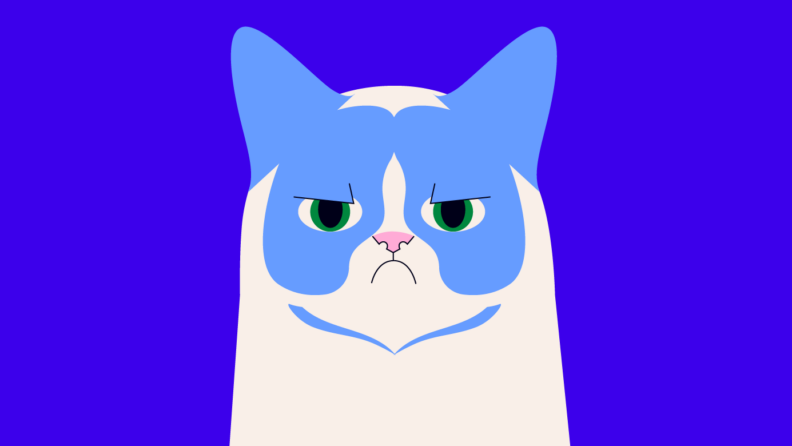Now more than ever, we are seeing a rise in the “unhinged brand” or brands using chaotic conversational moments and memes for content.
If you don’t melt your brain with content all day like I do, Google defines a meme as an “image, video, piece of text, etc., typically humorous in nature, that is copied and spread rapidly by internet users, often with slight variations.” Think Success Kid, Distracted Boyfriend, and the infamous Grumpy Cat.
What Is Meme Marketing?
Meme marketing is the use of memes—humorous images containing a short bit of text—to promote your brand, service, or product. It's a fun and entertaining way to connect with your target audience, typically increasing engagement.
It could be referencing the co branded movie posters of Barbie and Oppenheimer (which wildly backfired for Warner Bros.), using Jennifer Lawrence eating hot wings to make relatable work content like girlboss, or changing Kourtney Kardashian’s pregnancy announcement to best serve your language learning platform like Duolingo.
Why is it relevant now?
Most (if not all) of these will have incited a groan similar to “omg I remember that one.” But chances are, you saw it in the context of a friend sharing something funny–one personal social media account to another. So, why are marketing teams scrapping traditional marketing and dipping into the meme barrel to find something to show their CEO at their weekly roundup?
It’s because memes have become one of the primary modes of digital communication for Millennials and Gen Zs, now reaching into the mainstream:
- Research by YPulse reveals that 55% of 13 to 35-year-olds send memes weekly, with 30% sharing them daily.
- Instagram alone witnesses a million memes shared daily, doubling the numbers from 2018.
- A survey by Forbes reveals over 60% of people say they would be more likely to buy from a company that uses memes in their marketing.
And so, memes are no longer confined to internet subculture; they have emerged as a legitimate avenue for marketing.
Legal Considerations For Meme Marketing
So, is that even legal? The word we should really focus on is copied. According to a legal site, there are two types of memes:
- Owned/Shared Memes: are those created by the marketing department, where they own or share the intellectual property (IP) rights to the meme.
- Third-Party Memes are those that the marketing department does not own the IP rights to. They tend to be more commonly used because of the social currency they hold (be it an image or video clip).
Below is an example of the difference between the two. You'll notice how MailChimp took their own spin on the Barbie branding (owned), while Gong took imagery directly from copyrighted materials (third-party).
The likelihood of an individual getting sued for posting a meme is quite low, however, for companies aiming to make a profit it's different. For this, Ronald Fletcher Baker LLP suggests "social media managers must tread carefully to avoid legal risks. Unsanctioned use of Third-Party IP can lead to copyright infringement claims, potential damages, and even account suspension."
The common argument
The common argument for using memes in marketing revolves around fair use, a defense against copyright infringement. Fair use cases involve four factors:
- The purpose and nature of the use
- The copyrighted work's nature
- The portion used in relation to the whole work
- The effect on the potential market for the copyrighted work
In the context of meme marketing, two of those raise questions. Firstly, if a for-profit business is using memes on organic social platforms, it could be considered a commercial endeavor. Additionally, since most memes only slightly modify the original image with added text, the issue of how much has been changed becomes relevant.
A case study: Pepe The Frog
There is legal precedent for this, involving Pepe The Frog. When Pepe became associated with the alt-right and InfoWars used him for a poster sold on their website, the original artist, Matt Furie, filed a lawsuit. The court denied InfoWars' fair use argument, stating that "meme-ification" did not diminish Furie's copyright ownership, emphasizing that copyright owners are entitled to protect their work against unauthorized uses, regardless of its popularity.
Considering this legal precedent, it becomes apparent that using someone else's copyrighted material in marketing campaigns can carry legal risks.
It’s essential companies consult actual legal experts to ensure they comply with copyright laws and avoid potential legal issues when using memes.
Tips For Effective Meme Marketing
Meme marketing is one of the many marketing campaign types you can try, and most marketers have a huge amount of fun doing it. With legality and best practices in mind, I have a few more tips to share:
1. Stay on Brand
Just like any marketing approach, you'll want to ensure that the memes you use align with your brand identity and messaging. When contemplating a viral meme, ask if it complements your brand values, tone, and target audience. Will it resonate positively with your customers, or could it potentially cause confusion or disconnect? Remember, all memes do not work for all brands.
2. Don’t be offensive
Similarly, it's crucial to ensure that your meme remains non-offensive. Brands can find themselves in trouble when they jump on the meme bandwagon without carefully considering the implications. Before joining in, it's essential to ask a few critical questions about the meme's content:
- Does the meme mock or belittle a specific group or community?
- Does it contain insults, slurs, or offensive language?
- Does it rely on suggestive imagery or inappropriate language?
If the answer is "yes" to any of these questions, it's wise to reconsider.
3. Follow the “Meme Rules”
Meme blunders are truly cringeworthy, comparable to parents awkwardly using teenage slang. Here are a few simple rules to help you avoid such mishaps:
- Keep it Concise: Short and sweet memes are more effective. Avoid forcing it, or overcrowding with excessive text or elements.
- Opt for Readable Text: Ensure the text is large and easy to read, as viewers should grasp the message at a glance.
- Maintain Recognition: Customization is fine, but don't go overboard. The meme should still be recognizable to the audience.
- Respect the Original Meaning: Avoid altering the meme's core meaning, as it may confuse users and dilute its impact.
- No CTAs (Call to Actions): Keep memes free of sales-y or promotional messages. They are meant to entertain, not sell.
By following these guidelines, you can create memes that resonate with your audience, avoiding the cringy pitfalls of meme marketing gone wrong.
4. Use a meme generator
Have a trending image in mind and the copy you want to make it relevant for your brand? For simple creation, use a meme generator. Design tool Canva has a version of this you can use for free—it's 100% fully customizable and they even have a YouTube video tutorial on how to make hilarious memes!
5. Strike while the iron is hot
Timing is everything. Ideally, you share your meme when it's at its peak popularity, rather than after it’s already made the rounds.
When a meme is trending and capturing widespread attention, it presents a golden opportunity for your brand to join the conversation and gain traction with your audience. However, once the meme's popularity starts to fade, you may miss out on the chance to make a significant impact.
Meme Marketing Challenges To Consider
1. Like I said, they fade… fast
One of the defining characteristics of memes is their fleeting nature. They have incredibly short lifespans, often lasting from a few days to a couple of weeks. And, memes are highly context-specific, emerging from and reflecting the cultural environment in which they originate. Remember the "left shark" meme?
When used improperly (or just way too late), memes can inadvertently date your brand and alienate the very audience you're trying to engage. To stay relevant and appeal to your target audience, be mindful of the transitory nature of memes and ensure your marketing strategies remain fresh in other ways.
2. Lots of companies get it wrong
The risk of looking ridiculous is high. SaaS companies often cater to businesses and professionals who expect a level of professionalism. Memes, with their humorous tone, may not align with the image your company wants to project.
The Barbie and Oppenheimer flub from the social team at Warner Bros is a great example of how one mistake can be extravagantly costly. The Barbie movie team thought they were commenting on the mashup of a Barbieheimer poster with “It’s going to be a summer to remember” but Warner Bros. Japan condemned the comment. They believed the account was making light of the Hiroshima and Nagasaki bombings that killed 250,000 individuals.
3. They’re shallow
Memes are like a massive kiddy pool, lacking in depth but offering access to all. If you’re a diver or a pro swimmer, you’re going to want deep water to explore in. Same goes for audience engagement; depth is crucial to b2b content marketing, especially in the SaaS sector.
The only reason I'm talking about memes in marketing is the potential to join a viral trend and garner more attention. Memes build on a self-referential history. If you're not already familiar with the meme, you’re going to find yourself wondering why it's funny.
So, Should You Go Unhinged?
Honestly? Probably not. I know, it’s not the fun answer you hoped for.
While meme marketing can work well for certain industries and many B2C brands, SaaS companies should carefully consider whether it aligns with their brand identity, target audience, and marketing objectives.
While you're here, don't forget to subscribe to The CMO newsletter for more expert tips, trends, insightful interviews and software recommendations.


